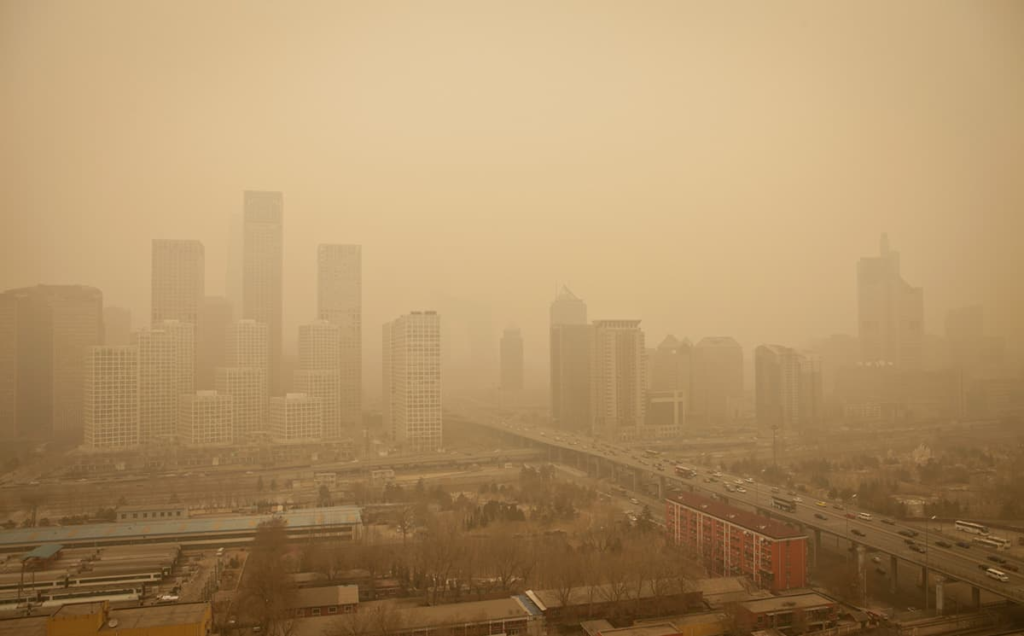Introduction
Particles in the atmosphere called aerosols have the ability to scatter and absorb light to dim
light, slowing down some reactions that cause smog in the troposphere’s lower layers while
sometimes speeding them up in the upper layers.

The English words “smoke” and “fog” are combined to create the term “smog.” The
phenomenon is perfectly described by this combination of words, which has spread across the
globe. Smog is defined in what way? It may very well be expressed that brown haze is simply
such a fake haze that was made in an unnatural manner because of human exercises and
certain troublesome conditions of nature.
Industrial smog typically forms in cool, humid environments and is gray in appearance due to
the presence of numerous tiny aerosol particles. It is important to keep in mind that industrial
smog, also known as sulfurous or black smog, is distinct from photochemical smog, which
typically develops during the summer when temperatures are higher.
Smog is pollution of the air that makes it harder to see. When heat and sunlight in the
atmosphere react with industrial emissions from power plants, factories, automobiles, and other
sources, smog forms. Smog can kill plants and is harmful to humans and animals. It can sting
your throat, nose, and eyes.
There are at least two distinct kinds of smog: photochemical and sulfurous smog. Sulfurous
smog, also known as “London smog,” is caused by an excessive amount of sulfur oxides in the
air and is brought on by burning coal and other fossil fuels that contain sulfur.
Photochemical smog, also known as “Los Angeles smog,” is most prevalent in densely
populated urban areas with a lot of automobiles. It doesn’t need fog or smoke. Nitrogen oxides
and hydrocarbon vapors from automobiles and other sources, which undergo photochemical
reactions in the lower atmosphere, are the source of this kind of smog.
The reaction of nitrogen
oxides with hydrocarbon vapors in the presence of sunlight results in the formation of the highly
toxic gas ozone, and the reaction of nitrogen oxides with sunlight results in the production of
some nitrogen dioxide. As a result, the atmosphere takes on a light brownish hue, making it
harder to see, harming plants, irritating the eyes, and making breathing difficult.
Ozone concentrations at the surface are considered harmful if they remain above 70 parts per billion for
more than eight hours; such circumstances are genuinely normal in metropolitan regions
inclined to photochemical brown haze.
The main factors that lead to smog smog aerosols is made when pollutants and exhaust gases from
human activities mix with air. Factories, an increasing number of automobiles, and stoves
burning coal, wood, and other solid fuels are to blame for this. The region’s weather, climate,
and general conditions also influence its formation. When a city is situated in a valley, it will be
much more challenging to eliminate pollutants because the lack of wind will prevent them from
spreading and thinning out, causing them to hang over the city.
Unfortunately, there is also the phenomenon of pollutants spreading to other areas, or “inflow
smog.” In one location, the air is certainly purified in this manner, but in another, it becomes
more polluted. It’s also important to know that traffic pollution in Los Angeles and London both
contribute to the smog that exists in Poland.

Conclusion of smog aerosols
Effects of smog—the result of air pollution The city’s residents should avoid breathing polluted
air because of the thick smoke that hangs over it. However, the effects of air pollution are much
more extensive than some people believe. It has a significant impact on human health, and
prolonged exposure can result in:
the onset of asthma and allergies, the onset of respiratory failure, a decrease in the body’s
immunity, the onset of cardiovascular and neoplastic diseases, and respiratory failure.
Consuming plants or meat from animals that were subjected to such conditions, for instance, is
one way in which the effects of smog can be experienced in an indirect way. This is due to the
fact that aggressive chemical factors also have an effect on materials (including building
materials), animals, plants, and people. In some cases, the effects of air pollution are delayed,
while in others, they are evident right away.
The greatest illustration of smog aerosols is the well-known Great
London Smog of 1952. Despite only lasting for five days, it was responsible for 4,000
respiratory-related deaths. In the weeks that followed, an additional 8,000 people perished.
Because the smog had such devastating effects, governments continue to debate ways to
lessen its impact.

